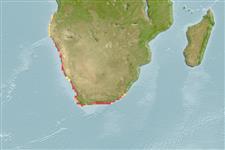>
Blenniiformes (Blennies) >
Clinidae (Clinids)
Etymology: Clinus: Greek, klinein, kline = sloping and bed, due to the four apophyses of sphenoid bone (Ref. 45335).
More on author: Valenciennes.
Environment: milieu / climate zone / depth range / distribution range
Écologie
marin démersal. Subtropical; - 35°S
Southeast Atlantic: north of Swakopmund, Namibia to False Bay, South Africa.
Taille / Poids / Âge
Maturity: Lm ? range ? - ? cm
Max length : 13.0 cm TL mâle / non sexé; (Ref. 5496)
Description synthétique
Clés d'identification | Morphologie | Morphométrie
Épines dorsales (Total) : 30 - 32; Rayons mous dorsaux (Total) : 6 - 7; Épines anales: 2; Rayons mous anaux: 20 - 22. Dark irregular crossbars, speckled with white and dark blue; tips of anal and pelvic fins red, supraorbital tentacles and tips of dorsal fin white; blue-margined ocellus on shoulder (Ref. 5496).
Occurs in tide pools.
Life cycle and mating behavior
Maturities | Reproduction | Spawnings | Egg(s) | Fecundities | Larves
Smith, M.M., 1986. Clinidae. p. 758-769. In M.M. Smith and P.C. Heemstra (eds.) Smiths' sea fishes. Springer-Verlag, Berlin. (Ref. 5496)
Statut dans la liste rouge de l'IUCN (Ref. 130435)
Menace pour l'homme
Harmless
Utilisations par l'homme
Outils
Articles particuliers
Télécharger en XML
Sources Internet
Estimates based on models
Preferred temperature (Ref.
123201): 15.5 - 22.5, mean 17.5 °C (based on 91 cells).
Phylogenetic diversity index (Ref.
82804): PD
50 = 0.5000 [Uniqueness, from 0.5 = low to 2.0 = high].
Bayesian length-weight: a=0.01096 (0.00423 - 0.02842), b=3.04 (2.82 - 3.26), in cm total length, based on LWR estimates for this (Sub)family-body shape (Ref.
93245).
Niveau trophique (Ref.
69278): 3.3 ±0.5 se; based on size and trophs of closest relatives
Résilience (Ref.
120179): Haut, temps minimum de doublement de population inférieur à 15 mois (Preliminary K or Fecundity.).
Fishing Vulnerability (Ref.
59153): Low vulnerability (10 of 100).
